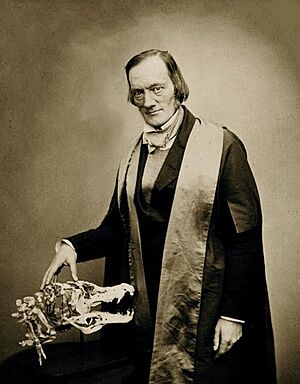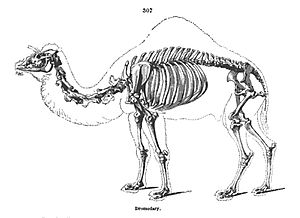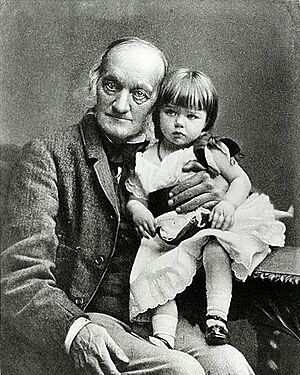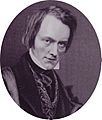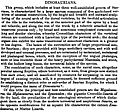Richard Owen facts for kids
Quick facts for kids
Richard Owen
|
|
|---|---|
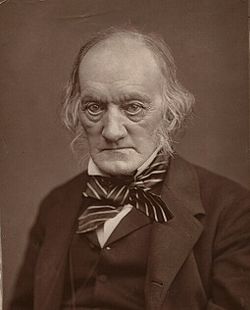
Portrait of Owen, c. 1878
|
|
| Born | 20 July 1804 Lancaster, England
|
| Died | 18 December 1892 (aged 88) Richmond Park, London, England
|
| Nationality | British |
| Alma mater | University of Edinburgh St Bartholomew's Hospital |
| Known for | Coining the term dinosaur, presenting them as a distinct taxonomic group. British Museum of Natural History |
| Awards | Wollaston Medal (1838) Royal Medal (1846) Copley Medal (1851) Baly Medal (1869) Clarke Medal (1878) Linnean Medal (1888) |
| Scientific career | |
| Fields | Comparative anatomy Paleontology Zoology Biology |
Sir Richard Owen (1804–1892) was an important English biologist, anatomist, and paleontologist. He was known for being very good at studying and understanding fossils.
Owen did a lot of scientific work. He is most famous for creating the word Dinosauria. This word means "Terrible Reptile" or "Fearfully Great Reptile". He also helped create the famous Natural History Museum in London.
Owen was a critic of Charles Darwin's theory of evolution by natural selection. Owen believed that evolution happened, but he thought it was more complicated than what Darwin described.
Contents
Richard Owen's Life and Career
Richard Owen started learning to be a surgeon in 1820. He joined the Royal College of Surgeons of England in 1826. Later, he became a professor there. In 1849, he became the head of the Hunterian Museum, London.
In 1856, Owen became the superintendent of the natural history section of the British Museum. He worked hard to create a new, big museum just for natural history. This led to the opening of the Natural History Museum, London in South Kensington in 1881. He was in charge until this big project was finished in 1883. After this, he was made a knight.
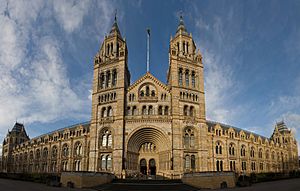
Owen received support from important people, including the royal family. He was given a cottage in Richmond Park. He also became a member of several important science groups around the world. He died in 1892.
Studying Ancient Life: Fossils and Dinosaurs
Owen was very interested in studying animals, both living and extinct. He was allowed to examine all animals that died at the London Zoo. This helped him learn a lot about animal bodies.
Discovering Invertebrates
Owen's first important book was about the Nautilus, a type of sea creature. He also studied sponges and discovered a tiny parasite called Trichina spiralis. He helped classify different types of Mollusca, which are soft-bodied animals like snails and squid.
Owen also studied very old footprints found in rocks. He correctly guessed that these footprints were made by an ancient type of arthropod, similar to a horseshoe crab. This was more than 150 years before any fossils of the animal itself were found!
Naming the Dinosaurs
Owen did a lot of work on reptiles, especially their skeletons. He studied many fossil reptiles from Britain. In 1842, he created the name Dinosauria. This word comes from Greek words meaning "terrible lizard."
He used three types of ancient reptiles to define dinosaurs:
- The meat-eating Megalosaurus
- The plant-eating Iguanodon
- The armored Hylaeosaurus
These fossils were found in southern England.
Owen also worked with Benjamin Waterhouse Hawkins to create the first life-size models of dinosaurs. These models showed how Owen thought dinosaurs looked. Some were made for the Great Exhibition in 1851. Later, 33 models were moved to Crystal Palace in South London. Owen even hosted a dinner for scientists inside a hollow concrete Iguanodon model!
Studying Ancient Mammals
Owen had a special arrangement with the London Zoo. He got to study any animal that died there. Once, his wife found a dead rhinoceros in their hallway!
He also studied many fossil bones from Australia. He described giant ancient animals like Diprotodon and the Thylacoleo. He also studied huge ancient kangaroos and wombats. Owen became the leading expert on the ancient animals of Australia and New Zealand. He also wrote books about British fossil mammals and birds.
Owen and the Idea of Evolution
Owen believed that new species appeared through a process of evolution. He thought this process was very complex.

Owen was careful about sharing his ideas on evolution publicly. This was because another book about evolution, Vestiges of the Natural History of Creation, had caused a lot of debate. Owen himself had been criticized for his own evolutionary ideas in his book Nature of the Limbs. In that book, he suggested that humans might have evolved from fish.
Owen and Darwin both studied "homologies." These are similar body parts in different animals, like the bones in a human arm and a bat's wing. They saw these similarities as proof that animals were related and had changed over time. Owen also showed how horses had changed over time, which supported the idea of development.
Owen had a famous disagreement with Thomas Henry Huxley about the brains of humans and apes. Owen claimed that human brains had special parts that ape brains did not. He argued that this made humans a separate group. Huxley disagreed and showed that apes did have these brain parts, just smaller. This debate was called the "Great Hippocampus Question."
Owen also argued that human brains were much larger for their body size than ape brains. He said this difference made humans unique. Huxley, however, pointed out that there were differences in brain size even among different human races. Owen countered that all human brains were generally similar in size and ability.
Owen's Lasting Impact

Richard Owen was the first director of the Natural History Museum, London. His statue stood in the main hall until 2009, when it was replaced by a statue of Darwin.
A type of lizard from Central America, Diploglossus owenii, was named after him. There is also a pub and a blue plaque in his honor in his hometown of Lancaster.
Challenges and Criticisms
Owen had some disagreements with other scientists. Some people described him as difficult and envious. For example, Gideon Mantell, who discovered the Iguanodon, felt that Owen took credit for his work. Some historians suggest that Owen even tried to stop Mantell's research papers from being published. Owen was removed from a scientific council for copying others' work.
Charles Darwin also felt that Owen was jealous of his book On the Origin of Species. Darwin wrote that Owen "hates me intensely." Owen wrote anonymous articles criticizing Darwin's work while praising his own.
Some authors believe that the negative image of Owen was made worse by his rivals. In the early part of his career, he was seen as a great scientist. However, his reputation declined later on. This was partly due to his disagreements with other scientists and some scientific mistakes he made. For example, his idea to classify humans in a completely separate group from other mammals was not supported by other scientists.
Owen continued to work even after he officially retired at age 79. However, he never fully regained the high respect he had earned in his younger years.
Images for kids
See also
 In Spanish: Richard Owen para niños
In Spanish: Richard Owen para niños



